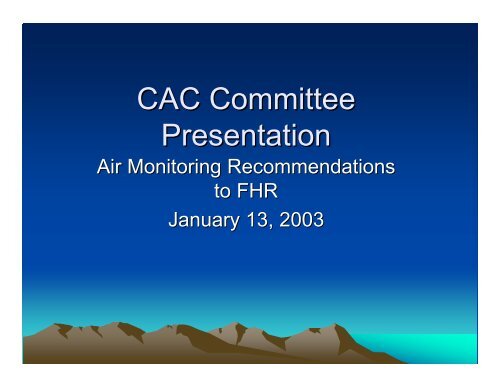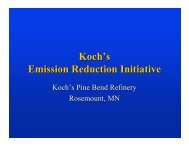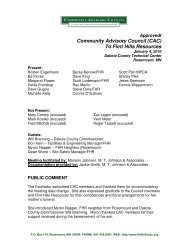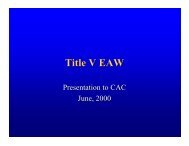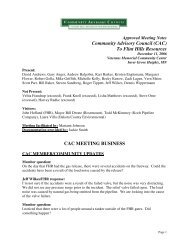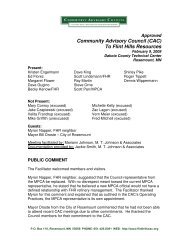CAC Air Monitoring Recommendations to FHR
CAC Air Monitoring Recommendations to FHR
CAC Air Monitoring Recommendations to FHR
- No tags were found...
Create successful ePaper yourself
Turn your PDF publications into a flip-book with our unique Google optimized e-Paper software.
<strong>CAC</strong> CommitteePresentation<strong>Air</strong> <strong>Moni<strong>to</strong>ring</strong> <strong>Recommendations</strong><strong>to</strong> <strong>FHR</strong>January 13, 2003
Environmental Committee Members• Ot<strong>to</strong> Ped• Frank Knoll• Greg Schuck• Gary Stevens• Joe Krisnik• Scott Parr• Jeff Wilkes• Dave Erlandson
Volatile Organic Compound (VOC)• Volatile – evaporating readily at normaltemperatures and pressures• Organic – chemistry – of or designatingcarbon compounds• Compound – substances with 2 or moreelementsExamples: benzene, <strong>to</strong>luene, formaldehyde,ace<strong>to</strong>ne, acrolein,
Volatile Organic Compound• Any chemical compound based on carbonchains or rings (also containing hydrogen)with a vapor pressure of 2 mm of mercuryat 25 degrees Centigrade, excludingmethane
Criteria Pollutants• A list of air pollutants identified in the 1970Clean <strong>Air</strong> Act• Criteria pollutants include: sulfur dioxide(SO2), nitrogen dioxide (NO2), VolatileOrganic Compounds (VOCs), particulatematter, carbon monoxide (CO), and lead(Pb).
Hazardous <strong>Air</strong> Pollutants (HAPs)• VOCs• Ammonia• Chlorine
Particulate Matter (PM)• Solid particles dispersed in<strong>to</strong> the air.– Most concerned about metals• Chromium, Nickel, Cobalt, Zinc, Lead, Manganese,and Barium
Acute Health Criteria• Concentrations of a chemical in air that thepublic can be exposed <strong>to</strong> over a shortperiod of time and not experience anyhealth consequences.• No more than 1 hour of continuousexposure
Chronic Health Criteria• Ambient air concentrations of chemicalsthat the public can be exposed <strong>to</strong> withoutharm continuously (i.e. 24 hrs/day; 365days/year) throughout their entire lifetime.
Sources of Emissions<strong>FHR</strong>OtherEmissions Sampled
Sample Frequency• Criteria Pollutant Subset – CO, NO X, , SO 2– Continuous• HAPs– 24 hour composite sample taken once every 6days– Not ideal for chronic or acute, but generallymore acceptable for chronic exposure
Moni<strong>to</strong>r Site Summary• Parameter 420 423 441 442• Carbon Monoxide CO X X• Nitric Oxides NO xX X• Nitrogen Dioxide NO 2X X• Sulfur Dioxide SO 2X X X X• Total Reduced Sulfur TRS X X• Hazardous <strong>Air</strong> Pollutants HAPs X X X X• Wind Speed WS X X• Wind Direction WD X X• Temperature Temp X X
<strong>Air</strong> <strong>Moni<strong>to</strong>ring</strong> Results<strong>FHR</strong>OtherChemicals coming from<strong>FHR</strong> (1998-2001)– Except for benzene allpollutantconcentrations werewell below annualcriteria
What chemicals not emitted by <strong>FHR</strong> haveconcentrations near the health limits?<strong>FHR</strong>Other• Acrolein– Lung irritant• Formaldehyde– Carcinogen• Carbon Tetrachloride– Carcinogen
What’s s not being moni<strong>to</strong>red?<strong>FHR</strong>Other• Many more chemicals being emitted thanare being moni<strong>to</strong>red• Relative health impacts were calculated– (Annual Emission Rate/Chemical ToxicityValue)• Emissions with highest potential healthimpact are all particulates (except chlorine)– Chromium compounds,– Nickel compounds,– Cobalt compounds– Zinc compounds– Chlorine– Manganese compounds
Results of Discussion with MPCA,<strong>FHR</strong>, and <strong>CAC</strong> Committee• MPCA just purchased analyticalequipment (ICAP) <strong>to</strong> measure particulates• The 24 hr average, once every 6 daysampling frequency will be used – ok forchronic• No solution for acute• MPCA recommended placement ofmoni<strong>to</strong>rs in all 4 directions <strong>to</strong> start
<strong>CAC</strong> <strong>Recommendations</strong>• Accept MPCA offer <strong>to</strong> do particulate testing– Verify quality control procedures• Place moni<strong>to</strong>rs at 4 sites surrounding <strong>FHR</strong>– (not limited <strong>to</strong> existing sites as new canisters are required)• Provide residents with a method <strong>to</strong> have air samples takenand analyzed on-demand– Important for acute sampling• Encourage <strong>FHR</strong> <strong>to</strong> continue and report on Benzenereduction program• Obtain information on Acrolein, Formaldehyde, and CarbonTetrachloride emissions and health effects from MPCA


